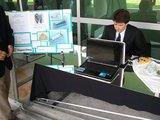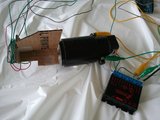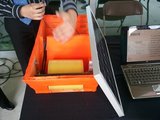
What do a plasma-guided rocket, aerodynamic bicycle farings, a life-size remote control and motion base, and an SUV car wash have in common? No, not that, get your head out of the gutter! ;-)
I got to see them all at the SDS and talk to the students who created them!
Today I'm returning to my environmental roots with an auto-adjusting solar collector and an autonomous oil skimmer.

It seems there's a solar trough at every SDS. One year it was designed to be made and used in impoverished countries, so it was built from oil drums and other readily available materials.
This year's solar collecting trough was much more sophisticated. All the usual characteristics were there: custom-designed parabola, special reflective film, custom mounting. Everything was done in metal; the parabola was too big for the student machine shop, so they had to redesign it in multiple pieces.
The real standout was the automatic guidance. If you look really closely at the tangle of wire and cardboard above, you'll see a photo-resistor on the cardboard divider. There's another one just like it on the other side. One of the students made a voltage divider that compares the two; the motor then rotates the mirror until both photo-resistors have the same voltage: the solar trough is pointing directly at the sun.
It's a cheap, easy method for keeping the collector as efficient as possible. It could be applied to photovoltaic solar cells, too.
Since they designed it to be installed on a roof in Florida, they also added a safety feature: when the wind is going to reach hurricane strength, the owner can flick a switch and the motor will turn the solar trough upside-down. Its parabolic bottom will be exposed, protecting the reflective surface and the electronics. It also becomes more aerodynamic: less sail-like, more wing-like. It can withstand Category 3 hurricane winds with no damage.

This little gem is an autonomous oil-skimmer. I'm always surprised, especially in a political season, how short some people's memories can be. These students remembered the Exxon Valdez and the big BP Horizon oil spill. And they designed this.
It's extremely light: about five pounds altogether. The body serves as both a flotation hull and an oil container. The solar panel recharges a battery that turns the big yellow drum at the front. The motion draws in water, propelling the craft very slowly forward; a rudder in the back (not currently attached) guides it.
The drum is simultaneously hydrophobic (water-repelling) and oil-philic (oil-attracting). It skims the oil off the water, clinging to the drum, where it gets scraped off by a plastic ruler just after the top. The oil runs down a channel to the back, where it's stored.
A small computer and GPS receiver guides the craft. When it fills up with one gallon of oil, it automatically returns to a collection point, where it's picked up and emptied.
The whole thing can be air-dropped by the thousands. Working together, they could clean up any oil spill.
The only problem is stability: on the open sea, they're very stable front-to-back, but not so much side-to-side. They're considering adding a pontoon. I recommended simply attaching three of them together in a triangle, since they're meant to be used in groups anyway.
Next week, we'll check out two electric vehicles: a boat and a hybrid golf cart!